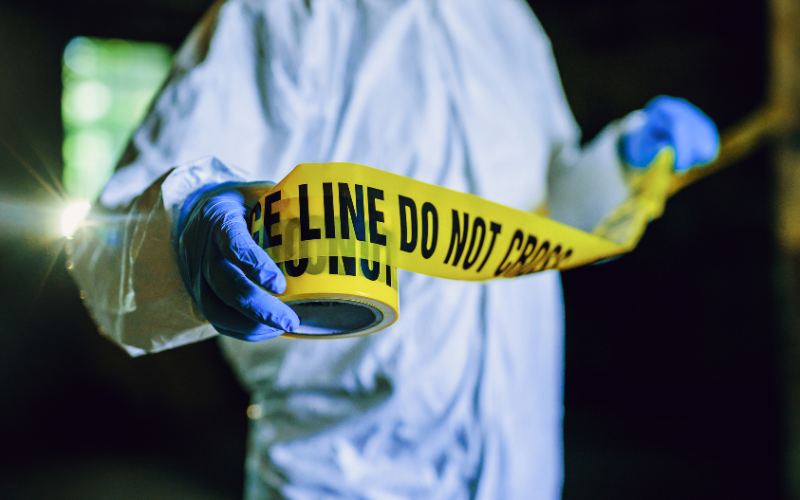Originally published by the Guardian.
Scientists are working at nanotechnology applications that may steer the power of forensics, but the challenge is bringing them from lab to court.
Imagine a crime scene: a person in a pool of blood, and a sheet of paper with a confused message, with overlapped sentences that appear to have been written by more than one hand. Some of the things forensic experts would do today are detecting fingerprints around the room, collecting samples of the blood and any other bodily fluids available, sending the document to a graphology expert …
Then, they would process these materials for several days. The fingerprints or DNA from organic materials may lead to an identification; if they don’t, then they would not be immediately useful. A graphologist may grasp some insights, but they may not be able to answer questions as basic as: which sentences were written first on the paper, and which after?
With exactly the same material, investigators would get to a much broader range of conclusions, if a set of nanotechnology applications currently being investigated finally gets into their hands. “Instruments used in nanotechnology labs, or nanoparticles themselves, have several uses in forensic science,” says Ian Turner, lecturer in biology and forensic sciences at the University of Derby. “Often, nanotechnology results in improving the sensitivity of already existing forensic techniques”, points out Bruce McCord, professor of forensic chemistry at Florida, International University, who worked at the FBI Forensic Science Centre from 1989 to 1998. The two remark that most of the work is at the experimental stage, but it is ripe to spill into the real world.
The most advanced applications are those related to fingerprints. Substituting materials used to develop fingerprints (such as carbon black, aluminium flake, and gentian violet) with much smaller nanoparticles increases by orders of magnitude the sensitivity of the forensic search. This makes it easier to detect old or faint fingerprints, and those left on difficult surfaces, such as adhesive or textured ones. Nanoparticles bind with the fingerprint’s pattern and make it visible. A typical strategy is engineering fluorescent nanoparticle to make the development easier.
But the improvement is not only in sensitivity. Nanoparticles can reveal information held by fingerprints that is currently inaccessible. In particular, they can be engineered to bring antibodies that bind with metabolites contained in the sweat of the fingerprint. These metabolites are breakdown products of the consumption of cocaine or nicotine. When the antibodies recognize the metabolite, they cause a colour change. This allows for “life-style intelligence”: that is, deducing elements of the lifestyle of people from the traces left on the things they touch. The company Intelligent Fingerprinting Limited, a spin-off of the university of East Anglia, has applied this concept into a portable device that can be used to quickly detect drug use through fingerprints.
Forensic applications of nanotechnology go beyond using nanoparticles. A classic tool of nanotechnology labs, the Atomic Force Microscope (AFM), could help with the paper message found in the crime scene described at the beginning of this article. This device allows details of a surface at the nano-scale level to be seen. It measures the forces exerted among a microscopic sharp tip and the atoms of the surface. This procedure can be used to examine ink crossings and determine which of two lines has been written over the other. This information could prove crucial in understanding certain documents, such as a contract with a contentious amendment.
Another forensic application of the AFM is finding out how old a sample of blood is. Blood gets stiffer in time, as red blood cells dry on a surface. As the blood gets older, the AFM’s tip needs more force to pull out from the blood surface: measuring this slight difference in force allows to date the sample.
Biofluids have even more to reveal when interrogated by nanotechnology-based applications. In 2013, McCord developed a system that mixes urine with gold nanoparticles and analyses the signal emitted when the mix is illuminated by a laser. His work focuses on benzodiazepines, known as “rape drugs”, because they are sometimes used to facilitate sexual assault. “A victim may be shocked and take days before going to the hospital, so we need to detect mingling traces,” he says. Physical properties of the nanoparticles as they interact with light provide the extra-sensitivity needed, down to the nanogram-per-mil concentration. While conventional methods mix urines with antibodies sensitive to a specific kind of drug, McCord’s is based on analysing the light spectrum, which detects a wider variety of drugs.
“My best guess is that the most promising application of nanotechnology to forensics lies in improving DNA analysis,” says Ian Turner. “Nowadays, analysing DNA requires a lot of time, money and multiple labs.” But, he points out, the main procedures – extracting, amplifying, separating, and sequencing DNA – have already been made quicker and portable, thanks to nano-techniques. “The challenge is combining them at a cost, with the objective to integrate a full laboratory on a chip: this would allow for quick and portable analysis,” he says.
McCord is pushing hard in this direction. In 2013, he published a genotyping system that reduces a procedure that was done in 2 days down to 25 minutes. This method, based on a microfluidic device that McCord is developing with Agilent Technologies, measures 13 locations in the genome of an individual that display patterns unique to that person. “Once such microfluidic devices become widely available, the police could check whether a suspect’s DNA is in its database in the time that person is kept at the police station,” says McCord.
“A sea change is about to occur for forensic analysis, based on next-generation sequencing, and is all based on nano-scale techniques,” says McCord. Two of the most promising lines, he says, are recognising what tissue is the origin of the DNA found on a crime scene (skin, blood, saliva, semen …) and deducing some phenotypic features of the owners of that DNA: geographical origin, colour of the eyes, skin, and hair, stature, etc.
So, going back to the crime scene of the beginning, investigators would get to a broader range of conclusions with nanotechnology tools: whether the actors of the crime were under drugs, when the blood was poured and the story of the document. But before this, more nanotechnologies have to migrate from the laboratory into the police’s hands.










